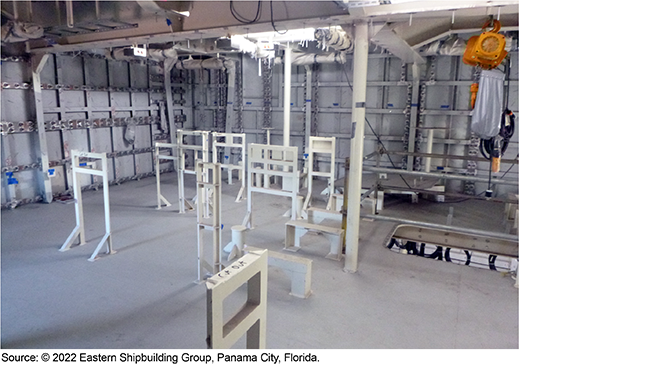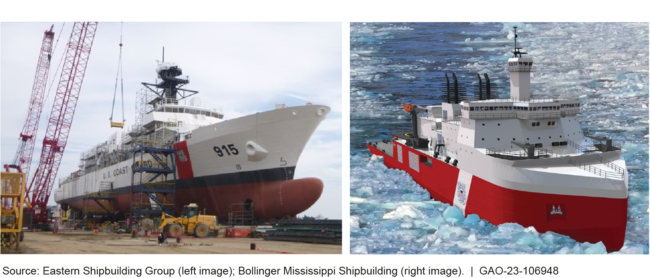Coast Guard Recapitalization: Actions Needed to Better Manage Acquisition Programs and Address Affordability Concerns
Fast Facts
The Coast Guard is modernizing its ships by investing billions of dollars in its highest priority programs.
We testified on our prior reports about programs that continue to face delays and rising costs—partly because the Coast Guard didn't have the right information about technology, design, or cost at key decision points.
For example, the Coast Guard aims to buy 25 new ships for offshore missions. But before building the first ship, it didn't complete critical portions of the ship's design—such as heating and cooling systems that affect multiple zones of the ship. As a result, the Coast Guard risks rebuilding portions of the ship and more delays.
The interior of an Offshore Patrol Cutter ship under construction

Highlights
What GAO Found
The Coast Guard is modernizing its vessels and aircraft, an effort known as recapitalization. Its newest cutters—the Offshore Patrol Cutter (OPC) and Polar Security Cutter (PSC)—are intended to deliver greater capability—such as time a ship can spend at sea without returning to port to resupply—than the legacy assets they will replace.
GAO's prior work shows that successful shipbuilding programs use solid, executable business cases to design and build ships. They attain critical levels of knowledge—such as mature technologies, stable designs, and realistic cost estimates—at key points in the shipbuilding process before making significant investments. The Coast Guard, however, continues to face cost growth and schedule delays in some of its newer acquisitions because it has not obtained the right knowledge at the right time.
Immature technologies. The critical technology of the first four OPCs—the davit (a crane that deploys and retrieves a cutter's small boats)—is still not matured. Without maturing the davit, the Coast Guard risks delays and costly rework.
Unstable design. The PSC's design is not yet stable, which risks an extended design phase and contributed to a 3-year schedule delay in the shipyard, with the start of construction of the first cutter now planned for March 2024. Starting ship construction without a stable design risks costly rework.
The Coast Guard's Offshore Patrol Cutter and Polar Security Cutter

Combined, these two programs are billions of dollars over their initial cost estimates and are more than 2 years behind schedule, increasing the risk of potential capability gaps and putting cost pressure on the overall portfolio. For example, in June 2023, GAO reported that the Coast Guard projects to have a reduced number of cutters available for operation starting in 2024 and through 2039 due to the OPC's delivery delays. Since 2010, the Coast Guard has invested at least $850 million to maintain the aging Medium Endurance Cutters and Polar Star . The Coast Guard is investing $250 million to extend the service life for six cutters and $75 million to extend the service life of the almost 50-year-old Polar Star until the delayed OPCs and PSCs, respectively, are operational.
Why GAO Did This Study
The U.S. Coast Guard, a component within the Department of Homeland Security, employs a variety of vessels and aircraft, several of which are approaching the end of their intended service lives. Consequently, the Coast Guard plans to invest billions of dollars in two of its highest priority programs—acquiring three heavy icebreakers, known as PSCs, and a fleet of 25 OPCs, which are ships that conduct a variety of missions in offshore waters.
This statement addresses (1) the capabilities provided by the newer Coast Guard surface vessels, (2) the risks and consequences of not establishing sound business cases for two of Coast Guard's highest priority programs—the OPC and PSC, and (3) the overall affordability of the Coast Guard's acquisition portfolio. This statement is largely based on information from GAO-23-105805 and GAO-23-105949. Information about the scope and methodology of prior work on which this statement is based can be found in those products.
Recommendations
GAO made seven recommendations in its 2023 reports on the OPC and PSC to better align the Coast Guard's acquisition policy and the programs' practices with shipbuilding leading practices. DHS and the Coast Guard agreed with five recommendations. Overall, GAO has made 40 recommendations over the past decade, 14 of which remain open. GAO will continue to monitor DHS's and the Coast Guard's progress in addressing these recommendations.
